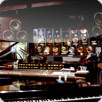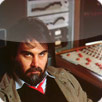
Nemo’s Control Room
Vangelis’ control room a couple months after completing the score to Blade Runner.
Vangelis’ main instruments consisted of a dozen of synthesisers, which lay behind the Quad/Eight Pacifica mixing desk. Visible are a Simmons SDSV drum pad and rack, an Emulator sampler, a MiniMoog synthesiser, and a Roland CR-5000 CompuRythm drums.
The keyboard at the bottom of the picture is an extremely rare synthesiser known as the Yamaha GS-1, which was also used on Blade Runner.
The Yamaha GS-1 was a big instrument, and normally resided in the live room, but it was brought into the control room whenever it was required.
Nemo’s Control Room
Vangelis’ synthesiser set-up during Blade Runner
The control room showing the Quad/Eight Pacifica mixing desk, E-Mu Emulator sampler, Moog MiniMoog, RSF Kobol BlackBox, and Roland CSQ-100.
For audio monitoring, the mix was played back on two large Tannoy Dreadnought monitors. Both monitor cabinets were equipped with Tannoy cones for high, middle, and low frequency ranges.
Each cone was independently powered by a dedicated BWG 750 Watt amplifier. The Tannoys were used as a primary source of audio monitoring in the studio. The headphones and small professional speakers on the mixing desk were seldom used.
Nemo’s Control Room
All the synthesisers shown here are the same as those used on ‘Blade Runner’ except for the Yamaha CS-40M synthesiser, which was missing from the set-up.
It was studio practice to record all of Vangelis’ projects on the multitrack tapes with dbx noise reduction Type I, as this allowed Vangelis’ wide dynamic range to be captured on analogue tapes with a minimal amount of loss in audio fidelity. These dbx machines provided coverage for the full 24 tracks of the Lyrec TR-532 tape machine.
Audio peak limiting was provided by URei 1176-LN compressors. A final mix was then produced on quarter-inch tape on the Ampex or Studer tape recorders.
From bottom to top, Vangelis' Rhodes Electric Piano with a built-in 10 band equaliser. The Roland VP-330 MK1 synthesiser. Roland CSQ-600 sequencer on top left, and Roland CR-5000 CompuRythm on top right.
From left to right, Yamaha CS-80, Simmons SDSV electronic drum, Lexicon remote control, Prophet 10, Steinway & Sons piano. The Prophet 10 synthesiser malfunctioned when Vangelis was finishing Blade Runner.
Nemo’s Live Room
The live room a couple months after completing the score to Blade Runner. The live studio was a multi-purpose area. It measured 23 by 44 ft and had a ceiling of 20 ft high.
This area was used for recording vocals and live percussion work. At the far end of the room was a large three sided cyclorama, which was used for creating very effective sound ambiences during live recordings.
Vangelis’ live area was filled with gongs, three hand-tuned timpani, bell trees, tubular bells, and various other percussive instruments. Vangelis digitally sampled some of these instruments and then accessed them via his digital sampler during the making of Blade Runner.
Vangelis’ Approach
Every film scene is accompanied with a unique composition reflecting Vangelis’ response to the images displayed on the video screen. Vangelis later recalled:
I always compose instinctively; everything came out naturally.
Vangelis records the composition straight to the multitrack tape machine. Often this first outtake could be used straight away for the scene.
Otherwise, if the composition needed minor additional layering Vangelis would request to his assistant engineer to rewind the multitrack tape, so he could add additional layers of sound. A composition could also be changed during post production and usually this was to add aural ambiances or sound effects.
In some instances a synthesiser melody was substituted with a vocal or a traditional instrument like a saxophone.
A view of the live room from right side of the previous photo. From front to back, vibraphone, crotales, and an unusual instrument: a grand piano harp with a buzz saw blade attached as a resonant percussive instrument.
Reappraising edits
Towards the end of the project as the score and film editing for Blade Runner was finalised, any new final tweaks to the edits were re-sent to Vangelis’ studio. He would then reappraise every new edit to see if it could be shortened or lengthened, or if a new composition should be replaced altogether. Vangelis later recalled:
Any changes that might have been made were sometimes made in a state of exhaustion but always in good spirits… I enjoyed the film and the collaboration with Ridley.
While this may have made completing the score a longer process for Vangelis, the final result ensured that every scene in the film was in tune with Vangelis’ creative flow.
Vangelis spent about 4 months recording and mixing the legendary Blade Runner soundtrack.
A number of guest performers’ vocals were used to enhance some of the incidental music, or to replace synthesiser lines with vocal effects on Blade Runner’s soundtrack.
The vocalists included The English Chamber Choir, Mary Hopkin, and Demis Roussos.
Once the lyrics of the songs were finished the vocalists would be asked to sing and perform the vocals in the adjacent live studio room to limit audio feedback coming of the monitors. The love theme featured in Deckard’s apartment was performed on a sax by Dick Morrissey, with Vangelis’ providing the musical backdrop on his synthesisers.

An overhead reconstructed 2-D view from Nemo Studio’s control room during the making of Blade Runner. It shows the arrangement of synthesisers, the recording equipment, and the seating locations of Vangelis and his studio assistant. Click on the next button at the navigation bar above to view the legend of the studio.
When writing the score for a film Vangelis would view the picture from a screen positioned at location TV no. 1. The studio assistant would view the picture on a television screen typically placed on the piano at TV no. 2. For added convenience sometimes a television screen was also placed at TV no. 3. Click on the next button at the navigation bar above to view some 3D renderings.
The following series of 3-D diagrams show the layout of the control room during one of the recording sessions of Blade Runner.
Vangelis worked on the score for weeks to perfect the soundtrack and make it in harmony with the visual power of the film. This resulted in emotive music which conveyed an atmosphere that had never been experienced before.
Vangelis finished Blade Runner’s musical score in April 1982. The film’s post-production and editing continued for a few more weeks before the film opened in UK cinemas on 9 September 1982.


